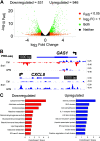Integrated genomics approaches identify transcriptional mediators and epigenetic responses to Afghan desert particulate matter in small airway epithelial cells
- PMID: 36062885
- PMCID: PMC9550581
- DOI: 10.1152/physiolgenomics.00063.2022
Integrated genomics approaches identify transcriptional mediators and epigenetic responses to Afghan desert particulate matter in small airway epithelial cells
Abstract
Military Deployment to Southwest Asia and Afghanistan and exposure to toxic airborne particulates have been associated with an increased risk of developing respiratory disease, collectively termed deployment-related respiratory diseases (DRRDs). Our knowledge about how particulates mediate respiratory disease is limited, precluding the appropriate recognition or management. Central to this limitation is the lack of understanding of how exposures translate into dysregulated cell identity with dysregulated transcriptional programs. The small airway epithelium is involved in both the pathobiology of DRRD and fine particulate matter deposition. To characterize small airway epithelial cell epigenetic and transcriptional responses to Afghan desert particulate matter (APM) and investigate the functional interactions of transcription factors that mediate these responses, we applied two genomics assays, the assay for transposase accessible chromatin with sequencing (ATAC-seq) and Precision Run-on sequencing (PRO-seq). We identified activity changes in a series of transcriptional pathways as candidate regulators of susceptibility to subsequent insults, including signal-dependent pathways, such as loss of cytochrome P450 or P53/P63, and lineage-determining transcription factors, such as GRHL2 loss or TEAD3 activation. We further demonstrated that TEAD3 activation was unique to APM exposure despite similar inflammatory responses when compared with wood smoke particle exposure and that P53/P63 program loss was uniquely positioned at the intersection of signal-dependent and lineage-determining transcriptional programs. Our results establish the utility of an integrated genomics approach in characterizing responses to exposures and identifying genomic targets for the advanced investigation of the pathogenesis of DRRD.
Keywords: deployment-related lung disease; particulate matter; transcription.
Conflict of interest statement
No conflicts of interest, financial or otherwise, are declared by the authors.
Figures






Similar articles
-
Single-Cell RNA Sequencing Reveals a Unique Monocyte Population in Bronchoalveolar Lavage Cells of Mice Challenged With Afghanistan Particulate Matter and Allergen.Toxicol Sci. 2021 Aug 3;182(2):297-309. doi: 10.1093/toxsci/kfab065. Toxicol Sci. 2021. PMID: 34051097 Free PMC article.
-
Respiratory Health after Military Service in Southwest Asia and Afghanistan. An Official American Thoracic Society Workshop Report.Ann Am Thorac Soc. 2019 Aug;16(8):e1-e16. doi: 10.1513/AnnalsATS.201904-344WS. Ann Am Thorac Soc. 2019. PMID: 31368802 Free PMC article.
-
Afghanistan Particulate Matter Enhances Pro-Inflammatory Responses in IL-13-Exposed Human Airway Epithelium via TLR2 Signaling.Toxicol Sci. 2018 Dec 1;166(2):345-353. doi: 10.1093/toxsci/kfy217. Toxicol Sci. 2018. PMID: 30169750 Free PMC article.
-
Role of Particulate Matter from Afghanistan and Iraq in Deployment-Related Lung Disease.Chem Res Toxicol. 2021 Dec 20;34(12):2408-2423. doi: 10.1021/acs.chemrestox.1c00090. Epub 2021 Nov 22. Chem Res Toxicol. 2021. PMID: 34808040 Review.
-
Deployment-Related Respiratory Disease: Where Are We?Semin Respir Crit Care Med. 2023 Jun;44(3):370-377. doi: 10.1055/s-0043-1764407. Epub 2023 Apr 17. Semin Respir Crit Care Med. 2023. PMID: 37068518 Review.
Cited by
-
Desert particulate matter from Afghanistan increases airway obstruction in human distal lungs exposed to type 2 cytokine IL-13.Front Med (Lausanne). 2023 Jun 28;10:1177665. doi: 10.3389/fmed.2023.1177665. eCollection 2023. Front Med (Lausanne). 2023. PMID: 37448802 Free PMC article.
-
Noncoding SNPs decrease expression of FABP5 during COPD exacerbations.J Clin Invest. 2023 Dec 19;134(3):e175626. doi: 10.1172/JCI175626. J Clin Invest. 2023. PMID: 38113113 Free PMC article. No abstract available.
References
Publication types
MeSH terms
Substances
Grants and funding
LinkOut - more resources
Full Text Sources
Research Materials
Miscellaneous

